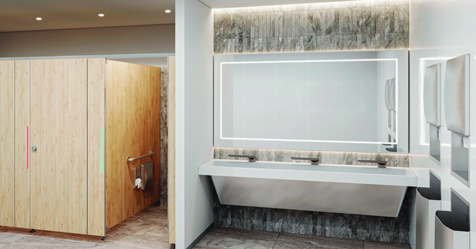Most of us now know that the focus of the professional cleaning industry is protecting human health.
Nowhere is this more important than in the cleaning and maintenance of public restrooms.
According to some reports, micrococacceae, which can cause skin infections, can be found in varying degrees on nearly all public restroom toilet seats.
Other bacteria found in varying degrees on toilet seats include:
- Coryneform, found on over 80 percent of all toilets tested, which can cause diphtheria and hepatitis
- Streptococcaceae, found on 39 percent of all toilet seats tested, which can result in sore throat and bronchial pneumonia
- Pseudomonadaceae, found on 22 percent of toilet seats, which can cause urinary tract infections and blood poisoning
- Enterobacteriaceae, found on 19 percent of toilet seats, which is associated with kidney infections, salmonella and shigellosis.1
Even small amounts of urine left on a toilet seat for up to 45 minutes can result in cross contamination.
The good news is that restroom users are unlikely to contract a disease merely by sitting on a pathogen-covered toilet.
Still, many people avoid touching toilet seats — or even all restroom surfaces — in order to minimize the possibility of getting sick due to cross contamination.2
So who is really at risk of getting sick due to pathogens on toilet seats?
None other than the cleaning professionals who must touch, clean and maintain restrooms on a regular basis.
Doesn’t Wearing Gloves Protect Cleaning Professionals?
According to Bob Merkt, a building service contractor (BSC), cleaning instructor and consultant, while restrooms typically account for only about 5 percent of a building’s total space, they are responsible for nearly 40 percent of a facility’s total soil load.
But, unlike soils that simply mar a facility’s appearance that can typically be removed with little concern for health or safety, restroom soils often contain germs and bacteria such as those mentioned earlier, which can cause illness or infection.
Typically, maintenance workers clean toilet seats and other restroom fixtures by hand using conventional cleaning tools such as sprayers, cleaning cloths, buckets and mops.
This is why most cleaning workers typically wear gloves when cleaning restrooms.
However, while gloves can offer a high degree of protection from harmful pathogens, cleaning workers need to know that this protection is not 100 percent.
In fact, the U.S. Centers for Disease Control and Prevention (CDC) reports that cleaning workers are at risk for exposure to pathogens if gloves have unapparent defects or are torn during use.
And since hands often become warm and moist, they are a perfect breeding ground for rapidly multiplying bacteria.
Further, many cleaning workers do not properly remove gloves after working.
We also know that many conventional cleaning tools, such as those mentioned earlier, can also spread germs.
In fact, the longer they are used, the greater the soil load, the greater the contamination concentration, the greater the risk of cross contamination.
With so many potential risks, the big question is what alternatives are available for cleaning workers to hygienically clean restrooms while still protecting their own health?
Alternatives And Options
During the past several years, new cleaning technologies have greatly improved restroom cleaning effectiveness, including pathogen removal.
For instance, microfiber cleaning cloths and flat mops tend to be more effective at removing contaminants than traditional cleaning cloths and string mops.
However, they still require the cleaning worker to touch surfaces.
Dual-bucket systems, which allow one part of the bucket to be filled with cleaning solution and the other with rinse water, can delay mops from becoming soiled and contaminated.
However, even with these systems, the cleaning solution becomes contaminated as soon as mopping begins.
Further, in the course of mopping, cleaning workers’ hands will likely come into contact with the soiled mop, bucket or both.
One of the options available that allows workers to clean restroom surfaces without touching them are so-called “no-touch” or “spray-and-vac” cleaning systems.
Introduced more than a decade ago, these systems are similar to pressure washers.
These machines apply cleaning solution to surfaces.
Then, after a few minutes of dwell time to ensure chemical effectiveness, the machine is used to pressure rinse and then vacuum the same surfaces, removing pathogens in the process.
No touching of any surfaces or fixtures is necessary.
The Final Step
Many studies have revealed the great number of people who do not wash their hands properly after using the restroom.
Some studies have even found that a surprisingly high number of healthcare workers do not wash their hands as often as they should during the course of their duties.
For cleaning professionals, whether using conventional cleaning methods or no-touch cleaning systems, there is a final step in cleaning that must always be completed: Proper handwashing.
This is true after all cleaning, but most especially after restroom cleaning.
1The study was conducted for Cocoon, an Australian manufacturer of protective coatings.
2Cross-contamination occurs in many ways. It is frequently caused by an individual touching a germ-laden surface and then touching his or her mouth, eyes or nose.
Dawn Shoemaker is a writer for the professional cleaning and buildings industries.
How To Remove Gloves Safely
- Grasp the outside edge of the left-hand glove at the highest point near the wrist.
- Peel the glove off the hand, essentially turning the glove inside out.
- Keeping the removed glove in the gloved right hand, discard the used glove.
- For the right-hand glove, slide the index finger under the glove at the highest point near the wrist.
- Peel the glove off from the inside and then discard.
- Wash hands using soap and water.


